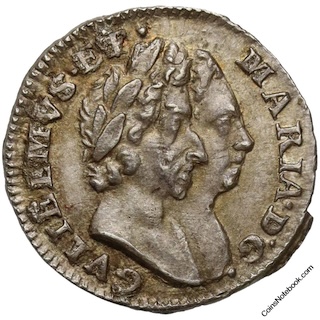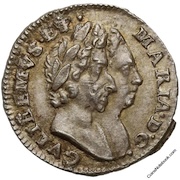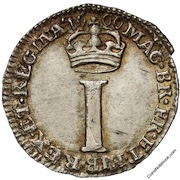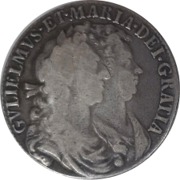
 The 1690 Silver Penny - William and Mary
The 1690 Silver Penny - William and MaryOnly silver pennies were struck in the reign of William and Mary, copper coins only extended up to halfpennies. The 1690 Penny varied from the 1689 Penny by having legend broken by the bust (before it was continuous). Minted at the Tower Mint in London. Sterling (0.925) silver. SCBC: 3445.
The Obverse shows the conjoined bust of William and Mary. Legend is "GVLIELMVS. ET. MARIA. D.G.". meaning "William and Mary by the Grace of God".
The Reverse shows a crowned "1" with date above. In those days the small silver coins had the same design as the Maundy coins. Legend is "MAG. BR. FR. ET. HIB. REX. ET. REGINA" showing that William and Mary were King and Queen of England, Scotland, France, and Ireland.
 This coin was graded as MS64.
This coin was graded as MS64.Image credit: The Royal Mint
Mintage: Not known
Minted at The Royal Mint
SCBC: 3445
More information (monarch, year, mint, country, category) can be found below coin listings.
Below are some coins currently being offered on eBay. As an eBay Partner, We may be compensated if you make a purchase.
List items on:
List items on:
Remember 1690 ?
William and Mary (1689-1694)
 William and Mary ruled jointly as King and Queen. Their actual titles are King William III and Queen Mary II of England.
William and Mary ruled jointly as King and Queen. Their actual titles are King William III and Queen Mary II of England.William III, also widely known as William of Orange, was sovereign Prince of Orange from birth. He was born in Binnenhof, South Holland, Netherlands.
Mary II (30 April 1662 – 28 December 1694) was Queen of England, Scotland, and Ireland. She was born at St James's Palace, London and was the eldest daughter of the Duke of York (the future King James II & VII), and his first wife, Anne Hyde.
Mary co-reigned with her husband, King William III, from 1689 until her death (When William continued as sole ruler).
The regnal years for William and Mary coins were:
1691:TERTIO; 1692:QVARTO; 1693:QVINTO (one extant); 1694:SEXTO.
On coins, their latin names of Gulielmus et Maria are usually used.
Category: Penny
The Penny is one of the most famous British coins. The coin itself has been around since 600AD and at various times has been struck in silver, copper and bronze. Originally split into halfpennies and farthing, it is now itself the least denomination coin currently in circulation. Made from copper (actually copper plated steel). Originally there were 12 pennies in one shilling and 240 pennies in £1; since decimalisation in 1971 there are 100 new pence in one pound.
Composition: Early pennies were Silver, then Copper, Bronze and Copper coated steel.
Which Mint: The Royal Mint
The Royal Mint is the designated place for the UK to mint coins. It dates back well over 1000 years and is a Government-owned company. Formed in the reign of Alfred the Great about the year 886, during the period 1279-1812 it was generally referred to as The Tower Mint as it was housed at the Tower of London. The Master of The Royal Mint has included famous figures such as Sir Isaac Newton.
Since 2010 it has operated as Royal Mint Ltd, a company owned by HM Treasury, under an exclusive contract to supply all coinage for the UK although it also produces medals and coins for other countries. It is currently located at Llantrisant, Wales.
Country of Origin: United Kingdom
The United Kingdom (UK) is the Union of England, Scotland, Wales and Northern Ireland. It is often refered to as Great Britain (GBR). It has a long, rich history. The orignal coinage was Pounds, Shillings and Pence but since decimalisation on 15 February 1971, it is £1 = 100p, that is One Pound = 100 pence. The coinage of the UK is also a long history, the Royal Mint being established as long ago as 886AD when coins were hammered. Today there is perhaps 30 billion coins in circulation, and many (numismatic) collectors coins and sets are issued frequently in gold, silver and other metals.






